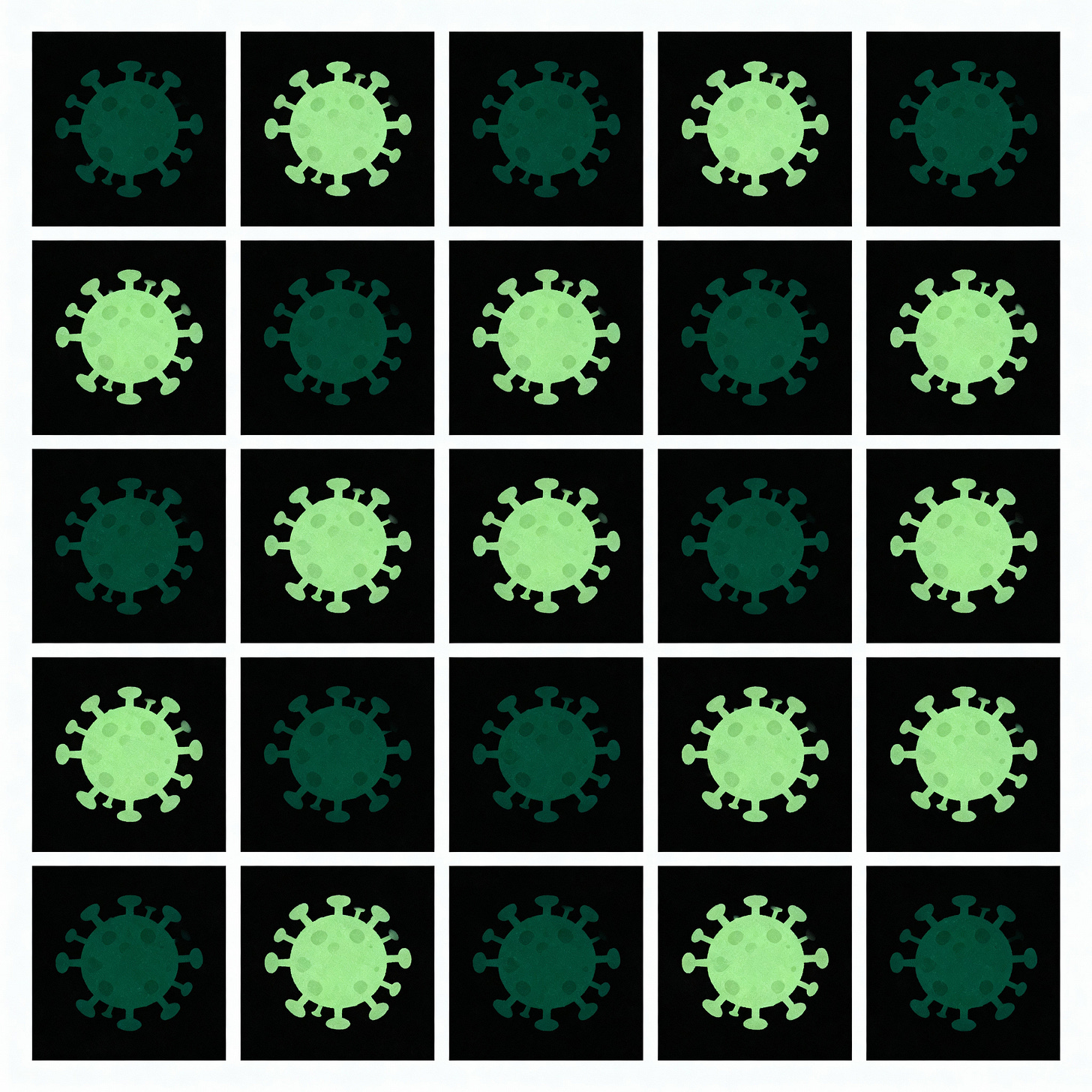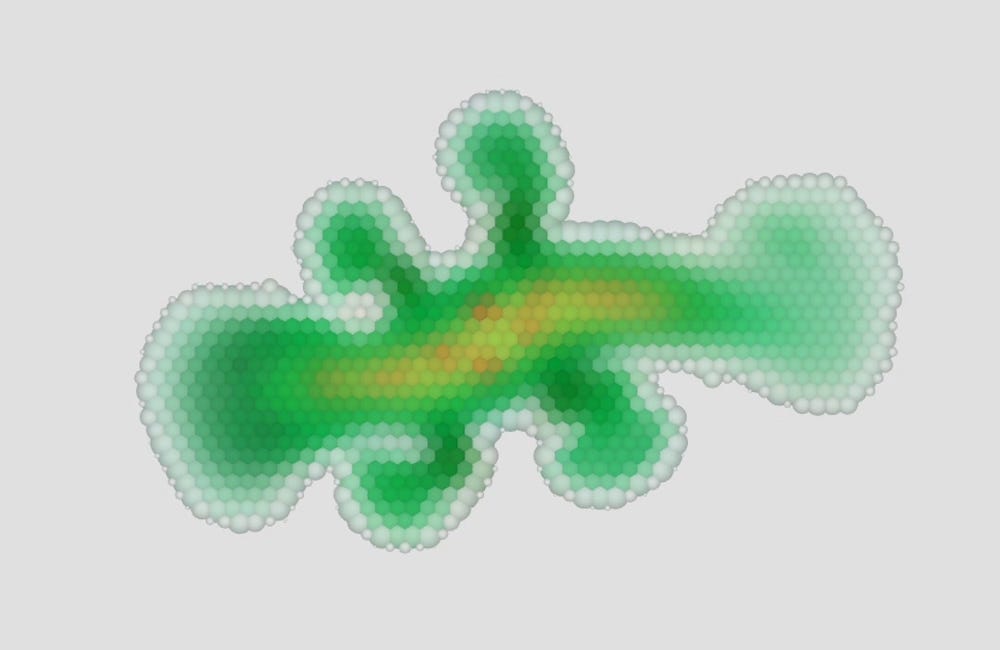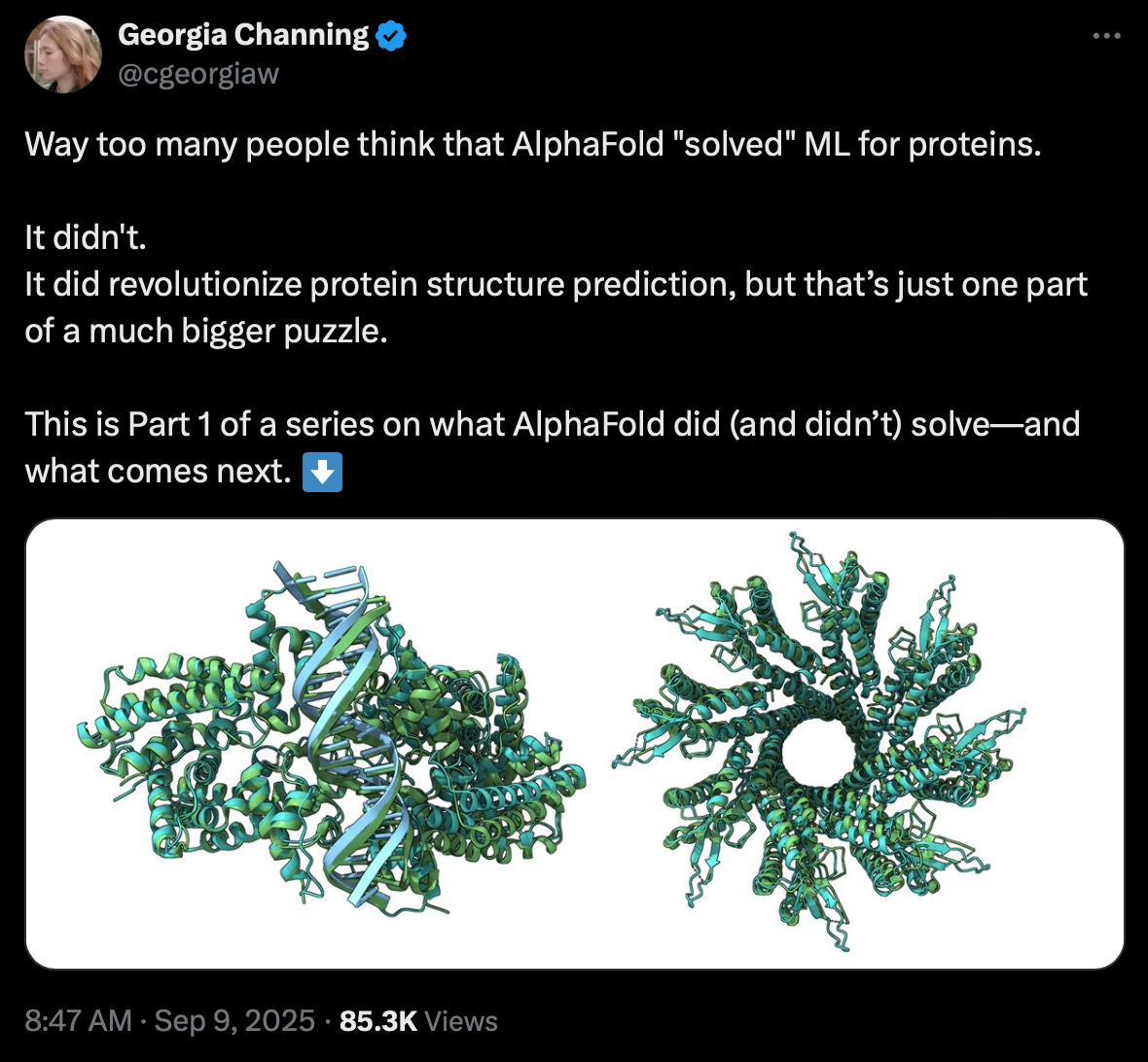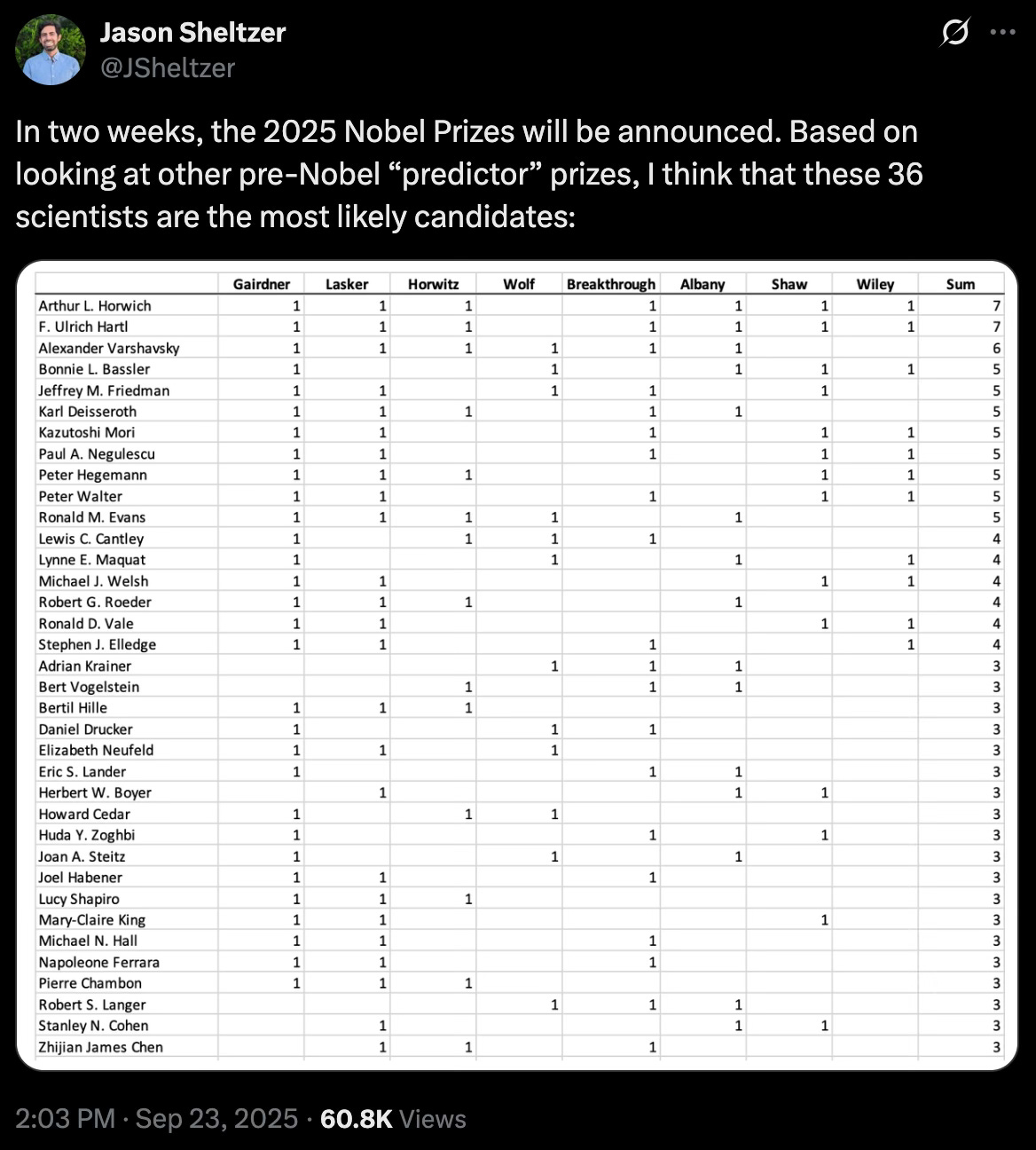BioByte 133: Reversing the 'Game of Life' in cells, Advancing Antibody Design with Germinal, Modeling Genome Evolution Across Species, and a Real-Time, Non-Invasive Imaging Device
Welcome to Decoding Bio’s BioByte: each week our writing collective highlight notable news—from the latest scientific papers to the latest funding rounds—and everything in between. All in one place.
What we read
Blogs
Self-Assembly Gets Automated in Reverse of ‘Game of Life’ [George Musser, Quanta Magazine, September 2025]
In the famous Game of Life in the 70s, generations of scientists saw how a few rules can generate the vast diversity in the natural world. In 2020, Mordvinstev, who was behind ‘deep dreaming’, brought this idea into the field of deep learning by creating Neural Cellular Automata (NCA).
The idea behind NCAs was reversed: instead of starting with rules and seeing what happened, Mordvinstev’s approach was to start with a desired pattern and elucidate what rules would produce it.
To start, a single live cell is used as a seed and then one compares the resulting pattern to the desired one. Over many steps, adjusted via backpropagation of genetic algorithms, the rules are learnt by the cell.
Applications are being actively explored for its use in computing and robotics. NCAs lack long-range connections like standard computers or neural networks, as the cells only communicate with their neighbours. Long-range connections require a lot of power, so if NCAs can do the same job as those systems, it could save energy. Other researchers are using them to program robot swarms, where smaller robots become a unified organism.
Building “Germinal” for AI Designed Antibody Molecules [Brian Hie, Xiaojing Gao, and Santiago Mille Fragoso, Arc Institute, September 2025]
The Arc Institute’s new platform, Germinal, demonstrates a practical route to epitope-targeted, de novo antibody design that works with low-throughput wet-lab follow-up. Rather than brute-force libraries, Fragoso et al. co-optimize structure and sequence: they use AlphaFold-Multimer gradients together with an antibody language model (IgLM) to bias designs toward plausible CDR conformations and “human-like” sequences, add targeted losses (paratope bias, secondary structure penalties), refine candidates with AbMPNN, and then rescore with AlphaFold3 and PyRosetta before selecting experimental hits. The point is pragmatic – can computational modeling and pre-selection reduce experimental screening from thousands to dozens of candidates while maintaining success rates? Germinal concretely proves this for a handful of diverse protein targets.
The workflow was tested on four targets (PD-L1, IL-3, IL-20, BHRF1). From thousands of computational trajectories the team advanced 101 PD-L1, 46 IL-3, 43 IL-20, and 52 BHRF1 designs into a NanoBiT expression / binding pre-screen (a split-luciferase binding assay) followed by biolayer interferometry for affinity measurements. Critically, verified hit rates ranged from ~4 – 22% depending on the target, and top binders reached nanomolar-range KDs (approximately 170 nM for PD-L1, 560 nM for IL-3, 190 nM for IL-20, 140 nM for BHRF1). IgLM guidance materially shifted sequences toward more human-like profiles and better developability metrics, and the expressed hits displayed robust mammalian expression – evidence that sequence priors help bridge design and manufacturability.
This is an important, measured advance: Germinal illustrates that joint structure / sequence objectives paired with a modest experimental budget can produce functional, expressible antibodies against chosen epitopes. The method does present some limitations – it functions on protein antigens with structured epitopes, its performance depends on structure predictor accuracy and prescreen filters – but they are ultimately tractable engineering challenges. Future work such as reducing computational cost and memory usage as well as broadening epitope classes and developability assays (ex. immunogenicity, polyreactivity, in-vivo activity) would enable generalization and wider adoption of the approach. Done cautiously, Germinal nudges antibody engineering away from brute-force screening to targeted, interpretable design.
Papers
Predicting functional constraints across evolutionary timescales with phylogeny-informed genomic language models [Ye et al., bioRxiv, September 2025]
Why it matters: Advances in natural language processing have enabled the development of powerful genome language models (gLMs). While the per-site likelihood predictions of these models have proven useful for predicting variant effect and even paved the way for designing whole new genomes, even the largest sizes gLMs struggle with variant interpretation for eukaryotic genomes. In this work, the authors describe Genomic Pretrained Network with Species Tree and Alignment Representations (GPN-Star), a gLM that utilizes whole-genome alignments (WGAs) and species trees to capture evolutionary relationships. With these capabilities, GPN-Star is able to model how genomes evolve across species and achieve superior performance on pathogenic and GWAS variants, as well as significant gains in trait heritability tasks and rare variant association testing, especially when compared to significantly larger contemporary models.
Unlike previous gLMs that used self-supervised learning tasks to learn from unlabeled DNA sequences, GPN-Star uses whole genome alignments (WGAs) and species trees to include explicit evolutionary information into its architecture. Incorporating evolutionary information into biological models is not new, with protein modeling efforts like AlphaFold making extensive use of multiple sequence alignments to model sequence and structure space. Previously, the benchmark standard for variant interpretation has come from phylogenetic models that leveraged WGAs. Prior work (GPN-MSA) pairing high quality WGAs with deep learning approaches showed strong performance but struggled to generalize across species that were too closely related since the model would become biased with one’s distribution. To mitigate this problem and keep the model useful for human genomes, training data had to exclude primates, effectively ignoring relevant evolutionary information.
Similar to other language models, GPN-Star uses a modified encoder-only transformer architecture. Trained with a masked language modeling objective, an input to the model consists of a WGA window with sequences from multiple species, as well as a species tree that reflects evolutionary distances between those species. GPN-Star learns to fill in masked tokens by leveraging information from within a sequence (referred to as a target sequence) as well as closely related genomes (termed as source sequences) from similar species. Importantly, GPN-Star “flexibly accommodates alignments of arbitrary composition and size,” which allows the model to incorporate information from closely related species unlike GPN-MSA. To that end, the team trained three versions (vertebrate, mammalian, and primate) of GPN-Star at different levels of taxonomic classification, with the largest 200 million parameter models requiring a “significantly more efficient resource footprint than previous gLMs.”
When evaluating GPN-Star’s predictive power, the team noted that “modeling longer evolutionary histories is not always optimal,” with the most significant gains coming in interpreting specific variants. On the ClinVar coding variant pathogenicity benchmark, GPN-Star recorded the highest AUPRC and matched the performance of ESM-1b, a model that explicitly reasons over protein sequences. The vertebrate GPN-Star was also able to achieve the highest performance on distinguishing between missense mutations found in cancers and those found commonly in the genome. Similarly, the model also excelled at predicting fitness effects from deep mutational scanning data benchmarks, being beaten only by the ESM-1b protein language model. Moving on to more challenging non-coding variants, GPN-Star was compared against models like Enformer, Borzoi, and the recently released heavyweight AlphaGenome. Even though such models were extensively trained on functional genomics data, they were still beaten by GPN-Star. Furthermore, GPN-Star also showed state-of-the-art performance in classifying promoter variants that impact crucial transcription and gene regulation processes. Finally, experiments also showed that GPN-Star helped improve performance on rare variant association testing tasks, as well as predicting causal variants for complex trait heritability.
The authors also studied how different levels of evolutionary information affected variant prediction. Analysis found that models trained on mammalian sequences showed superior performance on Mendelian trait variants, while the primate level model worked best for polygenic traits. Additionally, GPN-Star embeddings were found to be capable of capturing functional element types in the genome, with separate clusters for coding sequences and enhancers. Finally, the team also demonstrated the applicability of GPN-Star models for a variety of model organisms including mice, fruit flies, and roundworms. Models trained for each organism showed higher rare variant enrichment compared to standard phylogenetic tools. In summary, GPN-Star shows impressive results, especially considering its relative model size and training footprint. Grounded in biological principles like evolution, the model is a promising step forward in building increasingly powerful and interpretable gLMs. It will be interesting to see how GPN-Star-like methods can be combined with the functional genomics based models like AlphaGenome and perhaps yield greater insight into noncoding variant effects and trait selection within human populations.
Label-Free, Real-Time, In Vivo Optical Biopsy with a Handheld Quantitative Phase Microscope [Guang et al., bioRxiv, September 2025]
Why it matters: Surgical and dermatological decisions often depend on frozen-section histology, which is slow (~20-60 minutes), artifact-prone, and invasive. Label-based fluorescence imaging offers speed but carries toxicity risks and limited specificity in humans. Researchers from Francisco Robles’s lab at Georgia Institute of Technology / Emory University invent a handheld, low-cost imaging device that leverages their method quantitative oblique back-illumination microscopy (qOBM) to empower doctors with real-time, in vivo, histology-like visualization without staining or excision.
Guang et al. address a key gap in the existing microscopy suite: in vivo, real-time imaging with subcellular contrast. Prior label-free methods - optical coherence tomography (OCT) and reflectance confocal microscopy (RCM) - offer rapid in vivo imaging but lack subcellular contrast. Multiphoton approaches, on the other hand, are bulky, costly, and phototoxic. Quantitative phase imaging (QPI) is an emerging method that measures variations in a sample’s refractive index to map cellular/subcellular structure with nanometer-scale sensitivity, and like OCT/RCM is label-free! The Robles lab previously developed a new type of QPI called quantitative oblique back-illumination microscopy (qOBM). In this work, they show that they’re able to miniaturize qOBM into a handheld device with off-the-shelf components - empowering this label-free imaging modality to be physically flexible and widely manufacturable.
The probe integrates three optical components - a 0.8 NA gradient-index lens, a 20x long-working-distance objective, and a 75 mm tube, all coupled to 720nm LEDs arranged in orthogonal positions around the imaging tip. In order to build the subcellular images with these LEDs, they capture four pictures per cycle of LED firing, which are combined into two orthogonal differential phase-contrast images. These are deconvolved in Fourier space with the system’s optical transfer function using a Tikhonov algorithm to reconstruct quantitative phase maps. This gets them the following. A 0.8µm lateral resolution (which means they can make out subcellular structures as small as nucleoli). The whole picture they see is 300 µm x 300 µm. They get a 5 µm axial resolution (meaning that the depth of the tissue is a little blurrier than their x-y vision - they’re not able to peek into fine slices of tissue). It must be re-stated that this is non-invasive - they’re able to see different depths of tissue slices without surgically removing slices from the patient! Given their 720 nm LEDs, they’re able to see about 200 µm deep into tissue (with longer wavelengths they can penetrate deeper within tissue).
They validated the handheld probe to view a human forearm, mouse brain housing a glioblastoma, and a pig brain during surgery. The in vivo forearm imaging resolved keratinocytes, rete ridges, Langerhans cells, and flowing red blood cells (check out the videos they supplied in their supplemental material!). Ex vivo murine brain images captured cortical neuropil, nucleolated neurons, and GL261 glioblastoma regions with multinucleation and nuclear atypia. Human glioma specimens imaged within 6 hours of surgery showed nuclear hyperchromasia and pleomorphism that matched gold-standard H&E staining. Finally, the swine brain imaging under craniotomy conditions provided stable visual feedback that wasn’t affected by pulsation and respiration. Most of these contexts would otherwise require an invasive surgery - the handheld qOBM probe enables surgeons to get histology-like detail, live during an operation, without tissue removal!
Notable deals
Avenzo Therapeutics raised a $60M Series B round led by Orbimed and SR One. The funding will be used to advance Avenzo’s best-in-class small molecule and ADC oncology drug candidates. The company has several candidates in Phase 1 and 2 studies targeting advanced solid tumors and metastatic breast cancer. All existing investors—Foresite Capital, Lilly Asia Ventures, Surveyor Capital, New Enterprise Associates (NEA), Deep Track Capital, Sofinnova Investments, Sands Capital, INCE Capital, TF Capital, Delos Capital, and Quan Capital—participated in this most recent financing with new investor, Longwood Fund, also entering the fray.
AusperBio raised a $63M Series B2 co-led by Qiming Venture Partners and an additional undisclosed strategic investor. A developer of targeted oligonucleotide therapies for treatment of Hepatitis B, AusperBio reports that the funding from this round will serve to progress the company’s lead candidate, AHB-137, in Phase II clinical trials, as well as support the building out of their proprietary Med-Oligo™ ASO platform, and the expansion of clinical manufacturing partnerships and future pipeline. Other participating investors in the round include: HanKang Capital, CDH Investments, YuanBio Venture Capital, Sherpa Capital, and Genesis Capital.
Until Labs announced a raise of $58M for a Series A financing round led by Founders Fund. The company is currently developing their core product of organ cryopreservation whilst in pursuit of their long-term vision of whole-body medical hibernation and preservation. Originally developed using slices of neural tissue, Until employs novel molecular agents, perfusion and surgical protocols, and cooling and rewarming hardware to realize this reversible preservation technique, addressing the huge unmet need for organ transplants, which arises in large part from the severe timing constraints of current organ preservation methods. Until outlines recent development of a cryoprotective agent (CPA) discovery engine as well as further significant refinements of their product as they move into testing of preclinical model organs. Additional investors in this round include Lux Capital and Field Ventures.
Merck secured a $349M biobucks deal to continue partnership with Variational AI in pursuit of small molecule candidates for undisclosed targets. Reports from earlier this year revealed Merck was testing out Variational’s generative AI platform, Enki™, which conjures small molecules in response to target product profiles (TPPs) in a similar fashion to the text prompting used in popular AI image generation models. This deal illustrates Merck’s continued pursuit of greater AI integration into their internal workflows. Variational as well is no stranger to such partnerships, having disclosed deals with Rakovina Therapeutics, ImmVue Therapeutics, Oncocross, and Life Chemicals as noted in the deal coverage by Fierce Biotech. Merck will retain the exclusive rights to develop and commercialize any compounds generated via the collaboration, whilst Variational will receive an upfront payment of unknown amount with further payments contingent on milestones, together comprising the potential total deal value of $349M.
What we liked on socials channels
Field Trip
Did we miss anything? Would you like to contribute to Decoding Bio by writing a guest post? Drop us a note here or chat with us on Twitter: @decodingbio.















